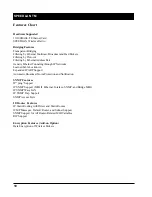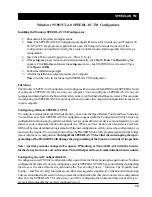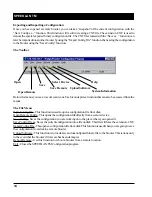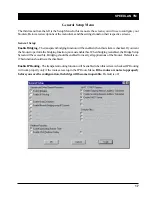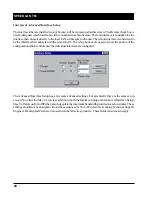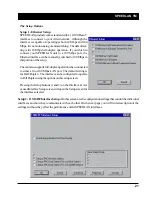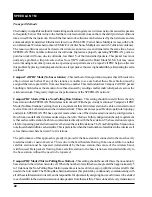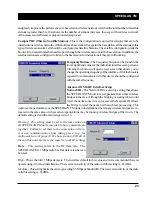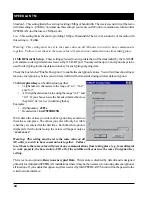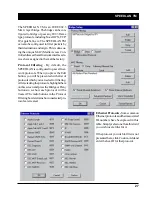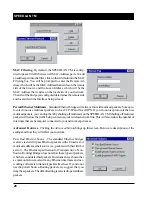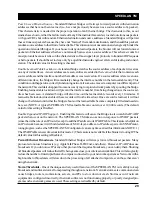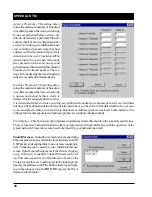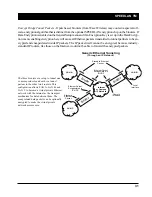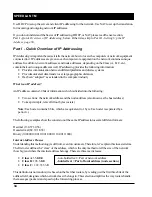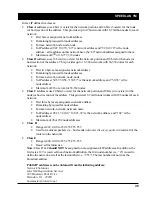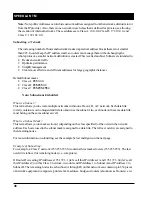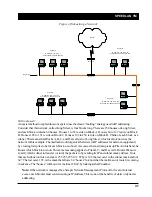
SPEEDLAN TM
22
Campus PRC Mode (This is a Polling Base Station)
- This setting should be used if this is the one and only
base station in the wireless network cell. When the number of satellites become greater then approximately 5
to 10 stations the Non-Polling Base Station sometimes is not as able to keep up with the wireless traffic that
needs to be forwarded. The Polling Base Station alleviates this problem by continuously communicating with
all of the satellite stations in its cell, and is responsible for dynamically assigning how much time is to be alotted
to each satellite in the next transmission of data packets from that satellite. This is done after every transmission
Campus Cell PRC Mode (No base stations)
- This method of transportation requires that all brouters be
able to detect each other. If any of the stations are unable to see each other then a Base Station must be
assigned that can repeat traffic from one brouter to another. This method utilizes Campus Cell PRC packet
bundling which reduces the amount of overhead caused by sending smaller individual packets across the
wireless network. This greatly improves the performance of the SPEEDLAN network
Campus PRC Mode (This is a Non-Polling Base Station)
- This setting should be used if this is the only
base station in the SPEEDLAN TM wireless network cell. With the previously mentioned ‘Campus Cell PRC
Mode (No Base Stations)’ setting there is a requirement that all wireless stations be able to transmit to and
receive from ALL other stations in the wireless network. This is not always possible due to particular topology
and terrain. SPEEDLAN TM has a special mode where one of the wireless stations can be configured as a
Base Station
and all other wireless nodes setup as
Satellite Stations
. In this configuration the only requirement
is that each satellite station be able to communicate directly with the base station. The base station is respon-
sible for repeating packets that need travel between the satellite stations. The Non-Polling Base Station does
not allocate bandwidth to each statellite. This is preferable when the total number of satellites in the wireless cell
is less then somewhere between 5 to 10 stations.
The performance of this approach is greatly improved if the base station is connected to the most heavily
loaded network or network server. This is due to the fact that data flowing from one satellite to another
satellite station must be repeated (retransmitted) by the base station, thus more of the wireless band-
width is used. Data packets flowing from a satellite station to the base station are transmitted directly to
the base station without the need to be repeated.
Transport Methods
The industry compatible method of transmitting and receiving data over wireless networks cause data packets
to frequently be lost. This is due to the fact that a wireless network does not have the ability to detect collisions
like a wired Ethernet network. On an Ethernet network collisions can be detected by the hardware and are
automatically retransmitted. Ethernet is refered to as CSMA/CD (Carrier Sense Multiple Access with Colli-
sion Detection). Wireless networks are CSMA/CA (Carrier Sense Multiple Access with Collision Avoidance).
The reason collisions can not be detected is wireless cannot receive and transmit at the same time, hence
SPEEDLAN TM is not able to listen for the collisions. In practice a properly operating SPEEDLAN point-to-
point network will loose, due to collisions, less than 1% of the transmitted packets. This packet loss is not
normally a problem with protocols such as Novell IPX (without the Burst Mode NLM)
,
but may cause
networks using most other protocols to experience poor performance. Campus Cell PRC helps to alleviate
this problem by placing multiple packets into one larger packet, thus saving bandwidth by eliminating the extra
overhead.
Содержание SPEEDLAN TM 6000
Страница 2: ......
Страница 6: ......
Страница 7: ...SPEEDLAN TM INTRODUCTION...
Страница 8: ......
Страница 11: ...SPEEDLAN TM 11 USING CONFIGURATOR...
Страница 12: ......
Страница 15: ...SPEEDLAN TM 15 CONFIGURING SPEEDLAN TM...
Страница 16: ......
Страница 25: ...SPEEDLAN TM BRIDGING SETUP...
Страница 26: ......
Страница 32: ...SPEEDLAN TM 32...
Страница 33: ...SPEEDLAN TM 33 Setting Up the IP Addresses IP Host Setup...



